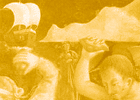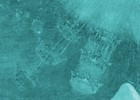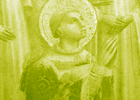| Home | About us | Contemporary | Resources | Contact us |
  |
|
Frescoes Forever's mission is to preserve and continue the fine art of mural painting, the spectacular technique of decorating ceilings, walls and other large surfaces. Our specialist focus is the technique of applying paint to wet plaster, known as fresco. The Italian word ‘fresco’ (literally the noun ‘buon fresco’ means ‘true fresco’) is used to describe the painting of a picture on fresh (damp) lime mortar or plaster. Other mural techniques apply paint on previously prepared (dry) plaster (‘fresco secco’). In contrast, fresh fresco painting applies wet colour to wet plaster which combines with the chemicals of the wall's surface to become a permanent part of the structure. Watching paint dry is not a derogatory term when referring to fresco painting! The lime white in the plaster combines with the wall paint to give an exceptionally clear, translucent effect, similar to the transparency of watercolour paint applied to paper or canvas. These paintings can remain intact for centuries. Some of the earliest murals date back over 31,000 years to prehistoric times and are still visible today in the Cave of Chauvet-Pont-d’Arc in southern France. Many others can be visited across Europe. early masters …In ancient Egypt, Greece and Rome during the period 6BC to 1AD, traditional mural painting was used primarily to decorate simple, flat surfaces and create immediate illusions of light in dark spaces. Some rare examples have survived of Egyptian tomb paintings (usually painted in secco) as well as Greek and Roman rural landscapes (usually painted in fresco). These paintings allow us a unique glimpse of early interior decoration and fashions. The beauty of this style then disappeared until fresco painting was rediscovered twelve centuries later during the Italian Renaissance.In the 13th century, the Tuscan artist Giotto introduced fresco painting once again to apply gentle tones of colour to his extraordinary life scenes drawn from nature. His subject matter, his style and his use of natural fresco pigments inspired and fascinated artists who continued using this technique uninterrupted for the next three centuries. The newly discovered rules of architectural perspective drawing, combined with the luminous colour palette of true fresco painting created a unique art form. Renaissance artists Masaccio, Michelangelo and Raphael used perspective to add an extraordinary illusion of space and depth to their fresco paintings. Artists were able to paint scenes on an unprecedented scale, using optical illusions to amuse and intrigue the public with fascinating surroundings in a way that 3D films now do for modern audiences. Fresco painting was developed further in increasingly sophisticated ways across the whole of Europe well into the 16th century Italian Mannerist period. recent developments …In order to appreciate the full breadth of modern wall painting, we should begin by considering the driving forces behind more recent trends in contemporary painting and how these changes have impacted this most ancient of art techniques. We begin to understand the reality behind the publicity by looking at the motivation and ambitions of those who commission and create the work.By the late 1800’s, mural painting once again retuned to the limelight. This time to add vigour and life to the growing trend for demonstrating national pride in a way that would have been difficult to imagine in Renaissance Europe. This ancient technique was to be applied to great effect in a completely new set of circumstances, with different objectives and in a very different culture. A wonderful example of this civic style can be seen in Stockholm’s national museum. The Swedish artist Carl Larsson painted six colourful fresco panels and two large-scale murals for the upper and lower staircases. These have been cleverly positioned in locations that help illuminate and preserve their original colour. This new vogue in mural painting was to be employed later to promote major revolutionary social and political change. During the Russian Revolution in 1917, mural paintings and large scale banners were often used to communicate the political ideals of the period and to win over and motivate large public audiences. Artists in China produced large-scale dramatic murals to promote the new political and cultural direction in the country following the 1919 May Fourth Movement. These murals appeared in stark contrast to the previous tradition of painting revered Buddhist figures in caves along the ancient Silk Road and on monastery walls in Tibet. Returning to the theme of social and political revolution, among the most famous muralists of the 20th century were the Mexican social realist painters, Diego Rivera, David Alfaro Siqueiros and José Clemente Orozco. In the 1920's they articulated their vision of social justice with a return to brightly colourful fresco painting. By 1937, this trend had returned to Europe where Picasso embraced the technique in his intense anti-war statement masterpiece mural, ‘Guernica’. By the 1930’s, the motivation behind modern mural painting had shifted fundamentally. Artists in the USA united in their efforts to create socially conscious public art within the far-reaching and innovative WPA cultural programme. By 1960 in Canada, York Wilson painted ‘The Seven Lively Arts’, then the largest mural of its kind, for the Hummingbird Centre for the Performing Arts in Toronto. The creation of public, socially-responsible mural painting continues in various forms to this day. and today …The greatest contemporary murals are those that truly reflect the times we live in. They draw on modern subject themes to illustrate the spirit and energy of communities across the world. Compelling paintings are created by a persuasive fusion of highly creative artists and visionary patrons. Such partnerships often combine with the influence of local cultures and fashions to create real shifts in style that evolve into tomorrow’s traditions. This transformation combines with the influence of local cultures and fashions to create shifts in style that evolve into tomorrow’s traditions. |
 |
 |
 |
 |
 |